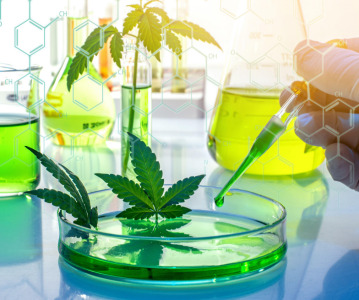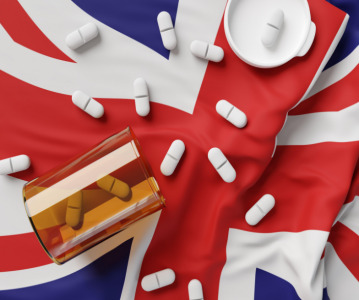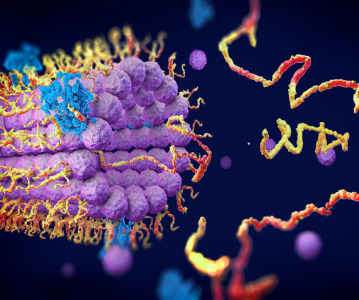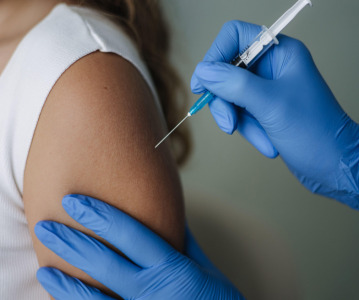Antidepressant may enhance drug delivery to the brain

NIH rat study suggests amitriptyline temporarily inhibits the blood-brain barrier, allowing drugs to enter the brain.
New research from the National Institutes of Health (NIH) found that pairing the antidepressant amitriptyline with drugs designed to treat central nervous system diseases, enhances drug delivery to the brain by inhibiting the blood-brain barrier in rats. The blood-brain barrier serves as a natural, protective boundary, preventing most drugs from entering the brain. The research, performed in rats, appeared online 27 April in the Journal of Cerebral Blood Flow and Metabolism.
Although researchers caution that more studies are needed to determine whether people will benefit from the discovery, the new finding has the potential to revolutionize treatment for a whole host of brain-centered conditions, including epilepsy, stroke,human amyotrophic lateral sclerosis (ALS), depression, and others. The results are so promising that a provisional patent application has been filed for methods of co-administration of amitriptyline with central nervous system drugs.
According to Ronald Cannon, staff scientist at NIH’s National Institute of Environmental Health Sciences (NIEHS), the biggest obstacle to efficiently delivering drugs to the brain is a protein pump called P-glycoprotein. Located along the inner lining of brain blood vessels, P-glycoprotein directs toxins and pharmaceuticals back into the body’s circulation before they pass into the brain.
To get an idea of how P-glycoprotein works, Cannon said to think of the protein as a hotel doorman, standing in front of a revolving door at a lobby entrance. A person who is not authorized to enter would get turned away, being ushered back around the revolving door and out into the street.
“For example, as good as vegetables are for us to eat, they have molecules that could be toxic if they slipped into the brain,” Cannon said. “They don’t get in, because of P-glycoprotein, but this same protector also keeps out helpful therapeutics.”
Cannon and his NIEHS colleagues initially found that amitriptyline significantly reduced P-glycoprotein’s pump activity in brain capillaries from wild-type rats. Later, they saw amitriptyline had the same effect in brain capillaries from genetically modified rats designed to mimic human ALS. In both rat models, amitriptyline turned off P-glycoprotein within 10–15 minutes. When amitriptyline was removed, P-glycoprotein pump activity returned to full-strength.
NIEHS postbaccalaureate fellow David Banks is lead author on the paper and described amitriptyline’s action on P-glycoprotein as rapid and reversible. It’s these advantages that make the therapy so appealing.
“Most inventions developed at the bench don’t make it to the clinic, but I’m hopeful that our findings will translate into better treatment options for doctors and their patients,” Banks said.Cannon anticipates that administering amitriptyline along with a lower dose of an opioid could relieve pain and reduce the negative side effects, such as constipation and addiction, usually seen with higher doses of prescribed opioids.
“As our nation faces increases in Alzheimer’s disease, autism, and opioid abuse, we’re hopeful that this discovery will help address these serious health challenges,” said NIEHS Director Linda Birnbaum.
Related News
-
News A Day in the Life of a Start-Up Founder and CEO
At CPHI we work to support Start-Up companies in the pharmaceutical industry and recognise the expertise and innovative angles they bring to the field. Through our Start-Up Programme we have gotten to know some of these leaders, and in this Day in the ... -
News Biopharmaceutical manufacturing boost part of new UK government budget
In their national budget announced by the UK Labour Party, biopharmaceutical production and manufacturing are set to receive a significant boost in capital grants through the Life Sciences Innovative Manufacturing Fund (LSIMF). -
News CPHI Podcast Series: The power of proteins in antibody drug development
In the latest episode of the CPHI Podcast Series, Lucy Chard is joined by Thomas Cornell from Abzena to discuss protein engineering for drug design and development. -
News Amgen sues Samsung biologics unit over biosimilar for bone disease
Samsung Bioepis, the biologics unit of Samsung, has been issued a lawsuit brought forth by Amgen over proposed biosimilars of Amgen’s bone drugs Prolia and Xgeva. -
News CPHI Podcast Series: Why we need to consider women in clinical trials
The latest episode of the CPHI Podcast Series with Lucy Chard covers women's health, specifically women's representation in clinical trials, the associated bias, and the impacts on health for this population. -
News US FDA does not approve MDMA therapy for PTSD, requests more data
The MDMA-based therapeutic developed by Lykos Therapeutics, a California-based Public Benefit Corporation (PBC), has been reviewed and unapproved by the US FDA. The regulator has requested additional phase III trial data for further safety and efficacy... -
News Novartis and Viatris latest facing lawsuit over HeLa cell misuse
Global pharmaceutical companies Novartis and Viatris are the latest hit with a lawsuit claim pertaining to alleged misuse of the ‘HeLa’ cell line from the estate of woman whose cancerous tissue cells were taken without consent. -
News Sanofi invests billions into Frankfurt insulin production site
French pharmaceutical company Sanofi have announced an investment of EUR1.3 billion at their existing BioCampus site in Frankfurt am Main for the expansion of insulin production.
Position your company at the heart of the global Pharma industry with a CPHI Online membership
-
Your products and solutions visible to thousands of visitors within the largest Pharma marketplace
-
Generate high-quality, engaged leads for your business, all year round
-
Promote your business as the industry’s thought-leader by hosting your reports, brochures and videos within your profile
-
Your company’s profile boosted at all participating CPHI events
-
An easy-to-use platform with a detailed dashboard showing your leads and performance



.png)

.png)
.png)
.png)